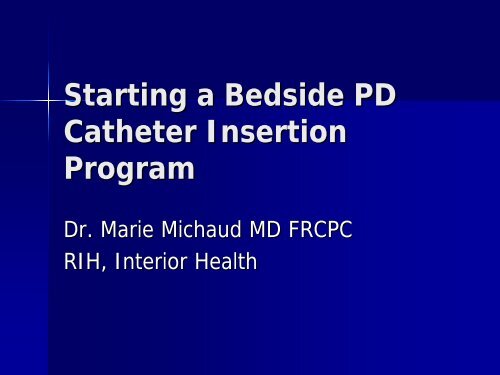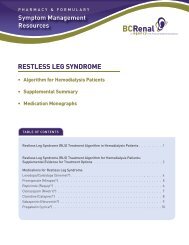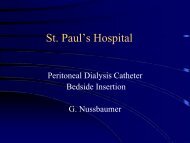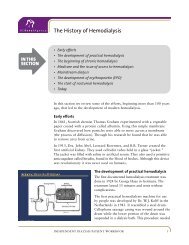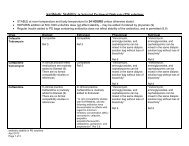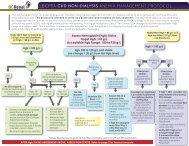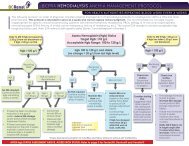Starting a Bedside Peritoneal Dialysis Catheter ... - BC Renal Agency
Starting a Bedside Peritoneal Dialysis Catheter ... - BC Renal Agency
Starting a Bedside Peritoneal Dialysis Catheter ... - BC Renal Agency
Create successful ePaper yourself
Turn your PDF publications into a flip-book with our unique Google optimized e-Paper software.
<strong>Starting</strong> a <strong>Bedside</strong> PD<br />
<strong>Catheter</strong> Insertion<br />
Program<br />
Dr. Marie Michaud MD FRCPC<br />
RIH, Interior Health
<strong>Bedside</strong> PD <strong>Catheter</strong><br />
Insertion Program<br />
• Introduction<br />
• Rationale<br />
• Requirements<br />
– Skills<br />
– Resources<br />
– Administration approval<br />
– Protocols<br />
• Technique<br />
• First 8 months<br />
– Successes<br />
– Problems<br />
• Goals for the future<br />
• Conclusion
Introduction<br />
• Kamloops serves the Thompson, Cariboo,<br />
Shushwap region of Interior Health with a<br />
catchment of 250,000 people<br />
• We have 600 CKD patients, 54 in-centre HD<br />
patients in Kamloops, 7 community HD patients in<br />
William’s s Lake, 5 home HD patients, and 32 PD<br />
patients<br />
• Thus PD, at 33% of our dialysis population is an<br />
important component of our program<br />
• We decided last fall to implement a program for<br />
bedside PD catheter insertions<br />
• Program was up and running in the end of January<br />
2008
Rationale for <strong>Starting</strong> <strong>Bedside</strong> PD<br />
<strong>Catheter</strong> Insertion Program<br />
• Control over the insertion date<br />
– No need to wait for surgeon and OR time<br />
• No general anesthesia<br />
• Control over the exit site:<br />
– Direction of exit site - lateral, caudal, not in fat<br />
fold or under belt<br />
– Size of exit site – puncture the size of the exiting<br />
catheter with no stitches<br />
• Control of the catheter type<br />
• Minimal pain and discomfort to the patient,<br />
immediate ambulation<br />
• Potential for immediate use if necessary (no large<br />
surgical incisions)
Initiation of Kamloops <strong>Bedside</strong><br />
PD Insertion Program<br />
• Skills<br />
• Resources<br />
• Administration
Initiation of Kamloops <strong>Bedside</strong><br />
PD Insertion Program<br />
• Skill requirements:<br />
– Nephrologist able to insert the catheters<br />
– Nurse able to assist in bedside catheter<br />
insertion
Initiation of Kamloops <strong>Bedside</strong> PD<br />
<strong>Catheter</strong> Insertion Program<br />
• Resource requirements:<br />
– Procedure room<br />
– Supplies<br />
• <strong>Peritoneal</strong> dialysis insertion tray -<br />
• General supplies: masks, sterile gloves/gowns, needles,<br />
syringes, sutures, chlorhexidine, , heparin<br />
• Drugs: xylocaine, midazolam, fentanyl, maxeran, ancef<br />
• Adult Trocath PD catheter with connecting tube and Cath-<br />
Clip catheter holder - $50/catheter<br />
• Tenckhoff double cuff PD catheter kit - $100/kit<br />
• Rigid introducer – made by our maintenance department<br />
• IV pole with Y-Type Y<br />
PD administration set, 2 litre drain bag<br />
and 2 litre bag of dialysis solution with heparin<br />
• O2 sat monitor and automatic BP cuff
Initiation of Kamloops <strong>Bedside</strong><br />
PD <strong>Catheter</strong> Insertion Program<br />
• Administration approval<br />
– Used pre-existing existing procedure room,<br />
– Supplies purchased from existing funds,<br />
– Current PD nurse incorporated bedside catheter<br />
insertions into her routine workload<br />
• Therefore, administration approval was not<br />
requested
Protocol preparation<br />
– Protocols adapted from VGH <strong>Bedside</strong> <strong>Catheter</strong><br />
Insertion protocols and RIH ACU for conscious<br />
sedation<br />
• Pre-procedure patient preparation protocol<br />
• Nursing protocol for<br />
– Pre-operative preparation of the surgical field,<br />
– Intra-operative assisting the nephologist,<br />
– Conscious sedation<br />
– Post-operative operative care and monitoring<br />
• Post-procedure patient instruction protocol
<strong>Bedside</strong> PD <strong>Catheter</strong> Insertion<br />
Technique<br />
• Midline incision 2 cm below the umbilicus then blunt<br />
dissection to linea alba<br />
• Blind puncture with trochar in rigid catheter through linea alba<br />
• Remove trochar and use rigid catheter to fill abdo with 0.5 -1<br />
litre heparinized dianeal<br />
• Use the Seldinger technique to insert the Tenckhoff catheter:<br />
– Insert guide wire through the rigid catheter, then remove<br />
catheter<br />
– Insert dilator with peel away sheath over guide wire<br />
– Remove dilator, insert soft Tenckhoff catheter stiffened by<br />
rigid stylet, , through the peel away sheath<br />
• Create exit site with one stab of scapel exact size of catheter<br />
• Tunnel to exit site
First 8 Months<br />
• Relatively cautious patient selection<br />
• Some growing pains<br />
– 8 catheters inserted with excellent<br />
function<br />
– 3 catheter insertions unsuccessful<br />
• One catheter inserted between the layers of<br />
the linea alba<br />
• Procedure called off in 2 catheters due to<br />
difficulties puncturing the linea alba<br />
• No complications
First 8 Months<br />
• Re-evaluation evaluation of resources required:<br />
– Realization that current nursing resources were<br />
actually inadequate<br />
– Timeliness of PD catheter access now affected by<br />
nursing availability rather than surgeon or OR access<br />
• Planned PD catheter insertions not a problem<br />
• “Crash on” patients still a problem<br />
– Not always able to accommodate urgent<br />
catheter insertion<br />
– Even more difficult to find nursing time to train<br />
unexpected patients<br />
– These patients are still ending up on HD with<br />
temporary lines
Future Plans<br />
– Additional funding<br />
• Formal RIH PD catheter bedside insertion<br />
project proposed and approved June 2008<br />
– Explore<br />
– 2 year project with 2 days per week of dedicated<br />
nursing time<br />
• Assist in catheter insertions and initial training<br />
• Develop policies and procedures based on best<br />
practice guidelines<br />
• Collection and compilation of stats for<br />
evaluation<br />
• Peritoneoscopic placement<br />
• Fluoroscopic confirmation of positioning
Conclusion<br />
• The implementation of a bedside PD<br />
catheter insertion program is:<br />
– Relatively straight forward<br />
– Relatively inexpensive<br />
– Offers a flexible and less invasive option to<br />
surgical catheter placement<br />
– May increase our PD numbers and decrease<br />
temporary HD requirements in patients<br />
previously awaiting OR time for PD catheter<br />
placement


